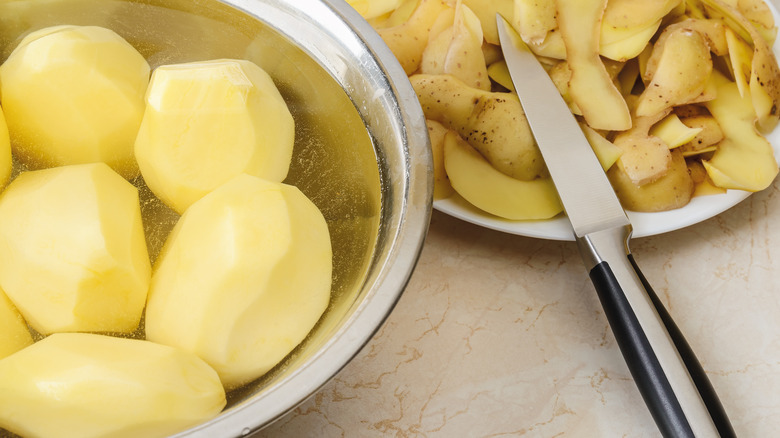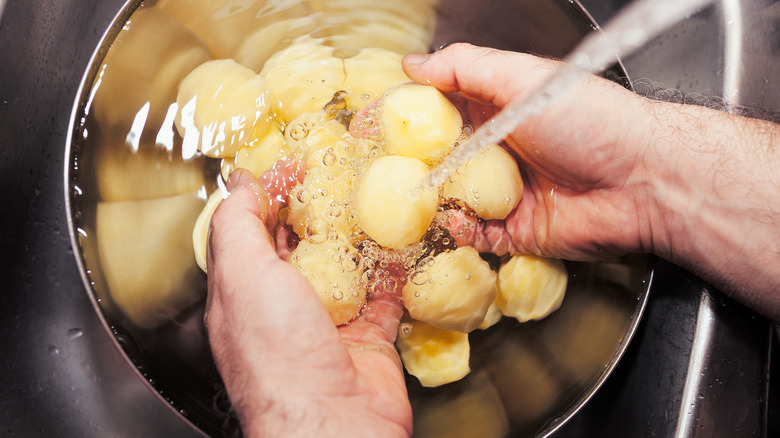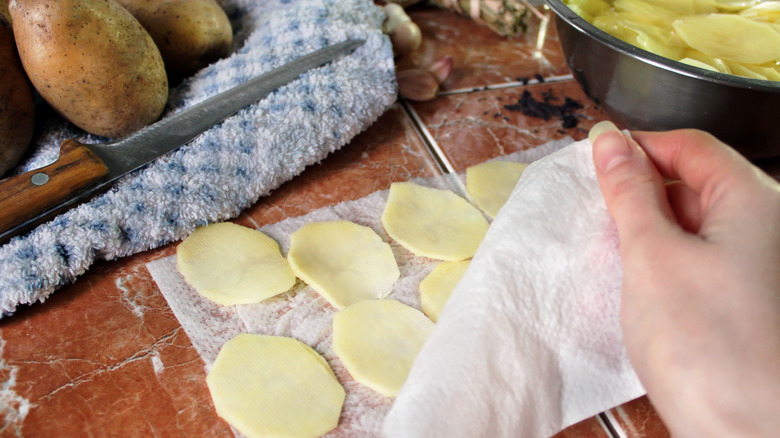How To Store Peeled Potatoes To Prevent Browning
Whether you're making crispy patatas bravas, golden french fries, or a comforting creamy mash, peeling potatoes is a necessary step — and it can be a tedious one. When you're preparing a big meal, having to peel and slice your spuds on the fly can add to an already-intimidating workload. However, if you've ever tried to prep potato dishes ahead of time, you know the biggest pitfall: They can start to turn an unappealing brown color soon after their skins have been removed.
There isn't really any way to stop potatoes from turning brown, a process called enzymatic discoloration. It's a natural process of oxidation that occurs when the sugars and starches in potato flesh are exposed to air. Still, you can store your tubers in a way that slows discoloration, so they keep their just-peeled creamy color for longer. The simplest method is to store peeled potatoes in cold water in the refrigerator.
Storing the peeled spuds in water means they won't be exposed to open air, and keeping them cool also helps to minimize discoloration. But to get the best results, you'll want to follow a few additional tips to prevent the texture of your potatoes from deteriorating, as well.
Store peeled potatoes in cold water with a little acid
Whether they're whole or sliced, store peeled potatoes in cold water ASAP to prevent oxidation. When it's time to peel them, have a container half-filled with water at the ready, and put the spuds in the water as soon as they're peeled and prepped. Then, top up the filled container with more cold water so they're completely submerged, and seal with an airtight lid before storing it in the refrigerator.
Peeled potatoes will last for up to 24 hours in the fridge, and it's important not to keep them for longer than this. If they sit in water for more than a day, they'll become waterlogged as the starches begin to break down. This makes the spuds soggy and grainy once cooked, so don't prep them too far ahead of time if you want to retain the best texture.
If you're storing the tubers in water for more than about six hours, you can give them a helping hand to retain their color by lowering their pH. Adding an acid such as lemon juice or vinegar to the water will help to preserve their integrity, but don't use too much, or your spuds will obviously taste like lemon or vinegar. Adding about a teaspoon into a half gallon of water is a good ratio. Ascorbic acid in the form of a crushed vitamin C tablet will have a similar effect.
How to prepare soaked potatoes before cooking them
Just like how certain types of potatoes work best in different dishes, some spuds also hold up better when prepared ahead of time. Waxy potatoes such as white potatoes or Yukon Golds fare better when stored in water, as they contain less starch than floury varieties such as Idaho or russet spuds. Peeled sweet potatoes can also be stored in water for 24 hours, though they tend not to discolor anyway, so it's more about the convenience of preparing them in advance.
No matter which type of potato you're using, follow a couple of extra steps before cooking them in order to obtain the best texture. If you're boiling them to make the best basic mashed potatoes, they can simply be rinsed before you proceed with your recipe. But if you're roasting chunks of taters, pat them completely dry before adding oil and putting them in the oven, as moisture inhibits crisping. If your spuds are going to be fried, rinse them before draining and drying them to remove excess starch, so they crisp up better.
If you want to store potatoes for longer than a day, the best method is to peel, chop, and vacuum-seal them so they're not exposed to air. They can last for a few days in the fridge this way. Alternatively, cook the potatoes in advance and freeze them, since potatoes do not discolor once cooked. This works especially well for boiled or mashed potatoes.



